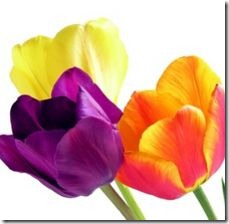Tulips are world-famous flowers that have intrigued gardeners for centuries. Today, they are one of the most popular flowers of all time, both in the United States and throughout the world, because of their many different shapes, sizes and colors. Gardeners interested in information about tulips should be aware of their characteristics and ideal growing conditions in order to make the best choices when planting tulips in their garden.
History
-
Holland is world-famous for tulips
Tulips were originally wildflowers growing in Central Asia before being cultivated by the Turks of the Ottoman Empire in the first century. It wasn’t until the 17th century that tulips were introduced into western Europe and began to be used as a garden flower. Tulips became very popular, particularly in Holland, where they were prized and sold for extremely high prices. Due to the intense interest in the flowers, botanists began to hybridize the flowers; today there are more than 3,000 varieties of tulips.
Description
-
 Tulips have either smooth or ruffled petals.
Tulips have either smooth or ruffled petals.Tulips are easily identified in spring by their bright colors in every shade imaginable except blue. Tulip blooms have six petals, which can either be smooth or ruffled, as in the case of newer hybrids. Tulips may be cup shaped, bowl shaped or goblet shaped. The blooms grow on a single thick stem which can be as short as 1 foot or up to 2 feet tall.
Types of Bulbs
-
 Tulips grow from bulbs.
Tulips grow from bulbs.Tulips are bulbous plants, which are flowering plants that grow from an underground, modified stem known as a bulb. Bulbs are classified by the time of year they are planted and by their hardiness. Tulips are considered hardy, spring-flowering bulbs because they are planted in the fall and they can survive a winter in the ground.
Tulip Divisions
-
 Kaufmanniana tulip is one type of tulip.
Kaufmanniana tulip is one type of tulip.There are several groups of tulips divided into three categories depending upon their bloom time: early flowering, midseason flowering and late flowering. Early-flowering tulips bloom in March and April and include the Kaufmanniana, Fosteriana, Single Early, Double Early and Greigii groups. Midseason-flowering tulips bloom in April and early May, and the most popular of these are the Lily, Fringed, Triumph and Darwin groups. Viridiflora, Single and Double Late, and Parrot all are categorized as late season tulips, which flower in May.
Ideal Growing Conditions
-
 Tulips prefer sunny locations.
Tulips prefer sunny locations.Tulips are most beloved because they are low-maintenance flowers that pack a punch that growers love. They grow best in organically rich soil that is well-drained but somewhat moist. Their ideal USDA growing zones are 3 to 8; they seem to fare best in regions with cool, moist winters and warm dry summers. Bulbs should be planted 4 to 6 inches deep and 4 to 5 inches apart. They are perennial flowers, but are often treated as annuals because their performance declines after the second year.
Diseases and Pests
-
 Slugs sometimes attack tulips.
Slugs sometimes attack tulips.Tulips are hardy flowers with no known insects or diseases, but gardeners should be wary of bulb and root rot, which occur in wet, poorly drained soils. Occasionally tulips may be plagued by gray mold and mosaic virus. Pests that attack tulips are aphids, slugs and snails.


Deprecated: strpos(): Passing null to parameter #1 ($haystack) of type string is deprecated in /home/agriviek8Qv/agriviet.net/public_html/wp-includes/comment-template.php on line 2522